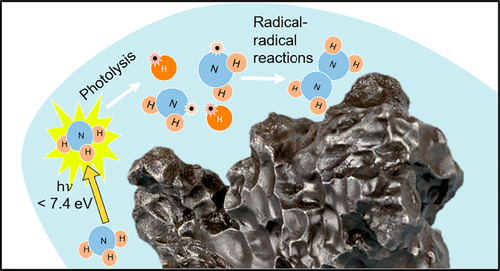当前位置:
X-MOL 学术
›
ACS Earth Space Chem.
›
论文详情
Our official English website, www.x-mol.net, welcomes your feedback! (Note: you will need to create a separate account there.)
Condensed-Phase Photochemistry in the Absence of Radiation Chemistry
ACS Earth and Space Chemistry ( IF 3.4 ) Pub Date : 2018-06-27 00:00:00 , DOI: 10.1021/acsearthspacechem.8b00027 Ella Mullikin 1 , Pierce van Mulbregt 2 , Jeniffer Perea 1 , Muhammad Kasule 3 , Jean Huang 1 , Christina Buffo 1 , Jyoti Campbell 1 , Leslie Gates 1 , Helen M. Cumberbatch 1 , Zoe Peeler 1 , Hope Schneider 1 , Julia Lukens 1 , Si Tong Bao 1 , Rhoda Tano-Menka 1 , Subha Baniya 1 , Kendra Cui 1 , Mayla Thompson 1 , Aury Hay 1 , Lily Widdup 1 , Anna Caldwell-Overdier 1 , Justine Huang 1 , Michael C. Boyer 3 , Mahesh Rajappan 4 , Geraldine Echebiri 1 , Christopher R. Arumainayagam 1
ACS Earth and Space Chemistry ( IF 3.4 ) Pub Date : 2018-06-27 00:00:00 , DOI: 10.1021/acsearthspacechem.8b00027 Ella Mullikin 1 , Pierce van Mulbregt 2 , Jeniffer Perea 1 , Muhammad Kasule 3 , Jean Huang 1 , Christina Buffo 1 , Jyoti Campbell 1 , Leslie Gates 1 , Helen M. Cumberbatch 1 , Zoe Peeler 1 , Hope Schneider 1 , Julia Lukens 1 , Si Tong Bao 1 , Rhoda Tano-Menka 1 , Subha Baniya 1 , Kendra Cui 1 , Mayla Thompson 1 , Aury Hay 1 , Lily Widdup 1 , Anna Caldwell-Overdier 1 , Justine Huang 1 , Michael C. Boyer 3 , Mahesh Rajappan 4 , Geraldine Echebiri 1 , Christopher R. Arumainayagam 1
Affiliation

|
We report postirradiation photochemistry studies of condensed ammonia using photons of energies below condensed ammonia’s ionization threshold of ∼9 eV. Hydrazine (N2H4), diazene (also known as diimide and diimine; N2H2), triazane (N3H5), and one or more isomers of N3H3 are detected as photochemistry products during temperature-programmed desorption. Product yields increase monotonically with (1) photon fluence and (2) film thickness. In the studies reported herein, the energies of photons responsible for product formation are constrained to less than 7.4 eV. Previous post-irradiation photochemistry studies of condensed ammonia employed photons sufficiently energetic to ionize condensed ammonia and initiate radiation chemistry. Such studies typically involve ion–molecule reactions and electron-induced reactions in addition to photochemistry. Although photochemistry is cited as a dominant mechanism for the synthesis of prebiotic molecules in interstellar ices, to the best of our knowledge, ours is one of the first astrochemically relevant studies that has found unambiguous evidence for condensed-phase chemical synthesis induced by photons in the absence of ionization.
中文翻译:

辐射化学缺失下的凝聚相光化学
我们报告了使用低于凝聚氨的电离阈值〜9 eV的能量的光子进行凝聚氨的辐照后光化学研究。肼(N 2 H 4),重氮(也称为二酰亚胺和二亚胺; N 2 H 2),三氮烷(N 3 H 5)和一种或多种N 3 H 3的异构体在程序升温脱附过程中被检测为光化学产物。产品产量随着(1)光子通量和(2)膜厚度的增加而单调增加。在本文报道的研究中,负责产物形成的光子的能量被限制为小于7.4 eV。先前对缩合氨的辐照后光化学研究使用了足够高的光子,以使缩合氨离子化并引发辐射化学。除光化学外,此类研究通常还涉及离子分子反应和电子诱导反应。尽管光化学被认为是星际冰中益生元分子合成的主要机制,但据我们所知,
更新日期:2018-06-27
中文翻译:

辐射化学缺失下的凝聚相光化学
我们报告了使用低于凝聚氨的电离阈值〜9 eV的能量的光子进行凝聚氨的辐照后光化学研究。肼(N 2 H 4),重氮(也称为二酰亚胺和二亚胺; N 2 H 2),三氮烷(N 3 H 5)和一种或多种N 3 H 3的异构体在程序升温脱附过程中被检测为光化学产物。产品产量随着(1)光子通量和(2)膜厚度的增加而单调增加。在本文报道的研究中,负责产物形成的光子的能量被限制为小于7.4 eV。先前对缩合氨的辐照后光化学研究使用了足够高的光子,以使缩合氨离子化并引发辐射化学。除光化学外,此类研究通常还涉及离子分子反应和电子诱导反应。尽管光化学被认为是星际冰中益生元分子合成的主要机制,但据我们所知,


























 京公网安备 11010802027423号
京公网安备 11010802027423号